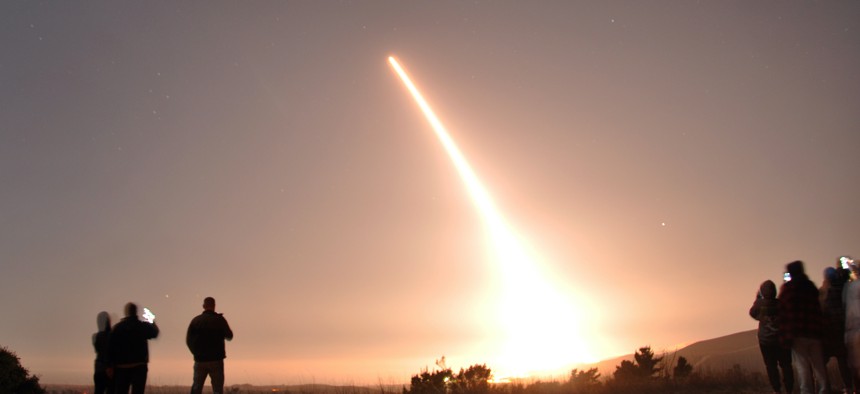
An Air Force Global Strike Command unarmed Minuteman III intercontinental ballistic missile launches during an operational test Oct. 29, 2020, at Vandenberg Air Force Base, California. U.S. Air Force / Tech. Sgt. Patrick Harrower
Strengthen U.S. Security Through Nuclear Arms Reductions
Biden has an opportunity to bolster deterrence, reduce proliferation risks, and lower the risk of nuclear war.
Thirty years after the end of the Cold War, nuclear weapons pose a far greater threat to the safety and security of Americans than is reflected in our public discourse. While the United States must maintain a strong nuclear deterrent as an important tool of U.S. foreign and defense policy, an oversized global arsenal of nuclear weapons makes Americans equally unsafe. It is time to reinvigorate arms control discussions to seek reasonable reductions that will make us all more secure.
Too many nuclear weapons increase the risk of theft by terrorists or other nefarious actors, encourage more countries to develop nuclear arms, and raise the risk of nuclear war. Reasonable arms control measures, taken in conjunction with adversaries like Russia, make Americans safer by diminishing the large Russian nuclear arsenal, reinforcing norms against the development and use of nuclear arms, securing or eliminating nuclear material from theft or misuse by terrorists, and saving money that can be used to strengthen the United States military’s conventional deterrence against costly and destructive wars.
In order to achieve those goals, Washington and Moscow have cut their strategic nuclear weapons since the height of the Cold War. Through the 2010 New Strategic Arms Reduction Treaty, or New START, which the U.S. and Russia recently extended, both countries each reduced their nuclear arsenals to no more than 1,550 deployed strategic warheads arming no more than 700 deployed strategic ballistic missiles and bombers.
Yet, despite these historic cuts, the United States and Russia each still have far more nuclear weapons than either side could conceivably use in a conflict, and at least ten times more weapons than any other country in the world. This actually makes Americans less safe, rather than the other way around.
In 2013, the Joint Chiefs of Staff concluded that the United States could safely reduce the number of deployed strategic warheads by one-third. The Biden administration should use that study—along with the current Nuclear Posture Review– to set the United States on the path to reasonable reductions.
The Biden administration should aim for new negotiations between the United States and Russian to limit each country’s armed forces to 1,000 deployed strategic warheads. The agreement can be executed incrementally, and the sides might informally agree once negotiations began to deploy no more than 1,400 strategic warheads, as an early confidence-building measure. This first step is an easy and safe one to take, as there have been times over the past decade when both countries already deployed fewer than 1,400 strategic warheads.
As part of a bold new vision for arms control and strategic stability, U.S. negotiators should seek an agreement that encompasses all U.S. and Russian nuclear warheads, including reserve (non-deployed) strategic warheads, and non-strategic nuclear weapons. Negotiators should work to limit all nuclear warheads to no more than 2,500 each, with an embedded sub-limit of 1,000 deployed strategic warheads within the overall aggregate limit. Even with the dramatic arsenal reductions outlined here, the United States would maintain the ability to deter and, if necessary, defend against any global adversary.
Such a nuclear arms reduction agreement would have significant additional advantages for the United States:
First, it could position Washington and Moscow to press China to freeze or limit its build-up of nuclear arms as long as the United States and Russia are reducing their nuclear arsenals.
Second, such an agreement could give the Pentagon additional resources to support wider force modernization requirements for nuclear and conventional forces alike, including new ballistic missile submarines and the B-21 bomber. If we have the forces to deter conventional conflict, we dramatically reduce the prospect of nuclear war.
Third, such an agreement would bolster America’s non-proliferation credentials and leadership. A new U.S.-Russia nuclear arms reductions treaty may not lead North Korea to abandon its nuclear program overnight, but it would increase the ability of U.S. diplomats to urge third countries to pressure and sanction outliers such as North Korea.
Right-sizing U.S. and global nuclear arsenals strengthens deterrence, reduces proliferation risks, and lowers the threat of nuclear war to the United States and our allies. The Biden administration has an opportunity to reduce that risk. It should seize it.
Rep. Ami Bera, D-Calif., is chairman of the House Foreign Affairs Subcommittee on Asia, the Pacific, Central Asia, and Nonproliferation. Steven Pifer is a William J. Perry Research Fellow at Stanford's Center for International Security and Cooperation.



